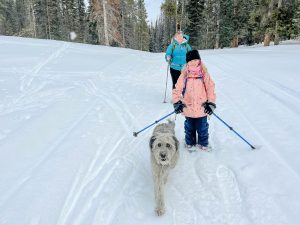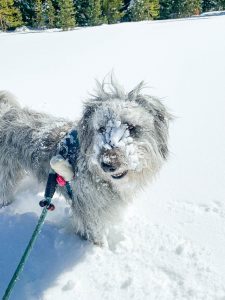
Trekking through the snow isn’t just for humans. Dogs can enjoy a romp through a winter wonderland, too. If you are planning to bring your pup on your next snowshoe adventure, follow these steps to ensure your best friend has as much fun as you do.
Choose Simple Trails
Snowshoeing burns a lot more calories than regular hiking. Pair that with the body working hard to keep itself warm, and energy expenditure increases. Therefore, you should look at shorter trails that feature little elevation gain to start with. As you and your dog get more comfortable hitting the trail and you both build stamina, longer and more difficult trails can be added to your list. Starting on trails at a Nordic center or snow park is perfect for those first snowshoe romps because trails are groomed and are distance and difficulty rated.
Know The Rules
Rules and regulations for where you can bring your dog will vary, so be sure to brush up on those before you start. It is important to check that where you are heading is dog-friendly. Some trails will be snowshoe-only, and some trails you will need to share with Nordic skiers. Some areas may allow dogs to be off-leash, and some may require you to have your furry friend on a leash at all times. You may even have to get a pass for your pup to join you on the trails for the day. If you are leaving from a trail center, ask one of the associates about the specific rules for the area.
Be Prepared For The Conditions
Watch the weather before you head out to be sure you have what you need to stay warm and safe. Conditions can change quickly in snowshoe-friendly places, so you don’t want to be out in the cold and unprepared. Look online for a trail status or check in with the trail center before heading out. Some trails may be groomed, but on some you may have to break through the snow. If you are in the mountains, there is also a potential avalanche risk. Check resources, including avalanche.org and the Colorado Avalanche Information Center for the most accurate safety information.
It is also important to have your pup hydrate more leading up to your trail adventure. Make sure they get in some good calories, too, so they have plenty of energy from the get-go.

Protect Your Pup
Dog paws are sensitive and can easily be cut by ice. Snow and ice can also build up on the fur around the pads, making walking painful and uncomfortable. While dog snowshoes aren’t available (future product development?), you can protect their feet with winter booties for cold and icy conditions. If you are snowshoeing in powder or deeper snow, you may be fine with just Musher’s Secret, a wax-based ointment. This ointment protects paws from snow and ice buildup.
Hypothermia and frostbite can even happen to canines. Fur alone may not be enough to keep your dog warm, especially if out in the cold for long periods of exposure. Some pups will need more coverage, especially shorter-hair breeds. Dog coats offer an extra layer of protection and can keep them dry if the snow falls. We recommend brands including Ruffwear, Mountainsmith and Wilderdog for great outdoor products for dogs.
A running leash may be helpful if you need to have your pup on a leash. This allows your dog to choose the best path for themselves with a bit of stretch. It also allows you to keep your hands gloved, and it will be easier to control your buddy if you are using poles.
Have a light and perhaps a leash or coat with reflective tape to make it easier to spot your dog along the trails. This will help in windy and cloudy conditions, too. It can also alert other trail users that a dog is coming up. A towel or warm blanket is important to bring along in your pack, along with water and snacks.
Take Breaks
Take it slow on the trails, especially if you are a newbie to snowshoeing with your pup. Stop periodically on the trail to grab some water and maybe some trail snacks. You may need to stop to brush off snow and ice from your pup’s fur or paws. Be observant of how your dog is feeling energy-wise.
Fatigue can set in quickly. It’s best to try to keep your pup on the trail where it is groomed or packed down. If they run ahead, they may do a lot of postholing, where they are breaking through and sinking in the snow. This will make your dog extra tired, as it takes a lot of energy to pop back up. It’s OK to turn around early if you or your pal are tired. Some signs related to hypothermia and frostbite are shivering, dilated pupils and slowed breathing. If you or your dog are experiencing any of these, it is time to get out of the cold and into warmer temps.
Just Have Fun
The popular saying “Life is about the journey, not the destination” rings true, especially when getting outdoors with your faithful companion. Trails that would take you an hour in dry, warm weather will take 30 minutes to an hour longer when dealing with winter conditions. You more than likely will have to stop more often to adjust equipment, check your dog’s paws and grab some water and a snack. Enjoy the scenery, the experience and a day outside with your fur baby.
Show Some Post-Snowshoe Love
After you finish your snowshoe trek, give your pup some love for joining you. Remove built-up snow or ice from their paws or other parts of their body. Dry them off with a towel. Have a favorite treat for the car ride home. Let them drink some water and relieve themselves before you leave the trailhead. Make them comfortable with their favorite blanket or snuggle toy for a good rest on the way home.





